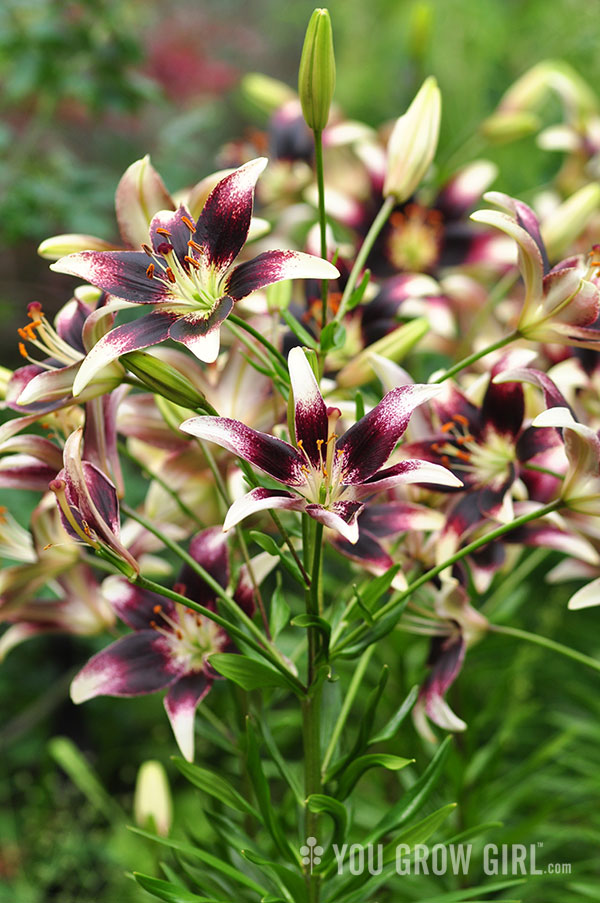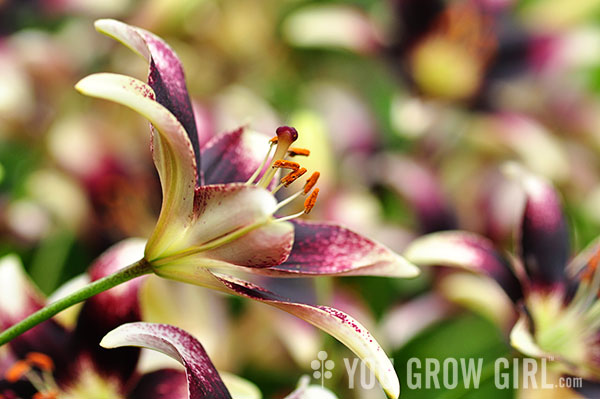
About a month ago the ‘Tiny Padhye’ lily put on a big show in the garden and I was careful to make sure that I captured it with my camera. A small packet of these dwarf lily bulbs appeared in my P.O. box back in spring 2012. I have never been able to recall where they came from and have felt especially bad about it since as they turned out to be one of the best lilies I have ever seen or grown!


This particular variety was originally bred for container growing, which is likely why it was sent to me as a tester. However, I’m really very glad that I was out of suitable pots at the time and planted these in the garden instead. Three years in and a handful of bulbs haphazardly dug into the front bed as an afterthought, have expanded exponentially into an impossibly wide patch thick with maroon and white wide star-shaped blooms. Bloom time only lasts about a week or so, but while they’re around the result is absolutely stunning and due to their position is the first thing that catches your eye as you enter the garden.

While it is technically good practice to cut the flower stems back directly after flowering (leave the foliage intact), I prefer to let mine hang around and form pods. I certainly haven’t suffered any loss of repeat blooms as a result since this particular plant seems to double its productivity each year. As the seedpods develop and age they lend an architectural statement to the front bed that lasts through the winter and into the following spring when I cut them back and the process of growth begins again.
Until recently I thought this variety was impervious to the lily beetle that has plagued other lily family bulbs in my garden. However, despite my diligence the dastardly beetles seem to have found it and now my daily patrols involve a pass around the foliage in search of the bright red beetles.

Growing Details
Hardiness: USDA Zones 3-10
Exposure: Full sun to partial shade.
Bloom Time: Mid-summer. Stays in bloom about a week or so.
Height: 18-24″ (I grow mine in partial shade and the height is closer to 36″.)
Soil: Well-draining. Mine is on the sandy side, but I work compost and/or manure around the bulbs in early spring to help boost soil texture and nutrition.
Care: Average moisture. Cut stems back after flowering (although I do not).
Additional: Makes a good cut flower. Scentless, dwarf, asiatic variety. Suitable for containers.
do you have any seeds of these beauties from those pods? I would love a few! I can send u a sase too ??
As I understand it, this variety is sterile.
What an eye catching contrast on this lily. The number of flowerheads is impressive. I can imagine it placed near Perilla, or a dark foliage Dahlia to be a color echo. Very pretty.
It’s the reverse of my Lilium ‘Lollipop’ which features reddish tips on each petal with white in the center.
http://www.alamy.com/stock-photo-lilium-lollipop-asiatic-lily-34519298.html
The intensity of the burgundy on ‘Tiny Padhye’ is darker, though, and the dots bleeding into the white make it unique, worthy of close inspection.
I feel fortunate to have no Lily Beetles (yet). I have been hearing about them for a couple years, dreading the day, checking regularly. My Lily collection is varied, but vulnerable. I hope the resident birds will come to my rescue and chomp down the numbers if and when the beetles appear. Or perhaps they don’t know they should eat this foreign invader. Thanks for reminding us to be vigilant. Love these photos.
So great that you don’t have lily beetles! Mine came on quickly so checking regularly is important. I suspect that they evade birds since the adults have that bright red colour that screams “toxic” and the larvae completely cover themselves in their own feces making them unpalatable! Tricky critters.
Hi. Any sources for these lovely lilies and for the guernsey lily you early showcased? I would love to plant them. Thanks for your fabulous website.
I’d love to try growing these next summer but I can’t seem to find their bulbs for sale anywhere! Hopefully that’s just because it’s so late in the year and I’ll be able to find them next year.